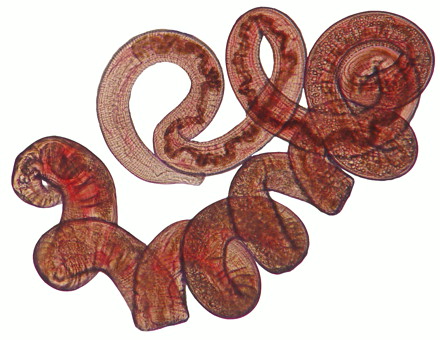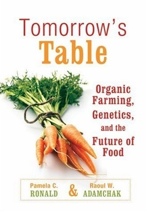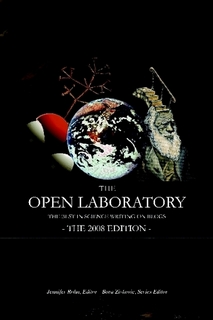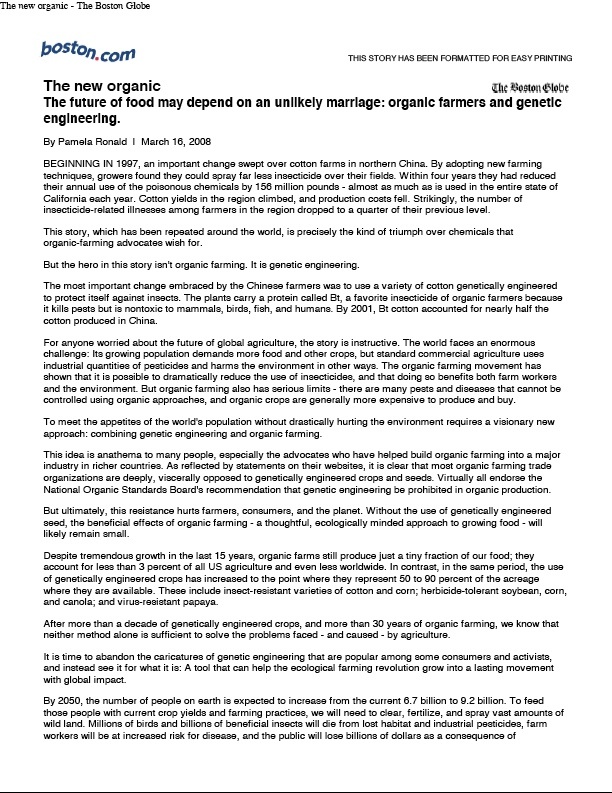Check out this great post by Mary M on biofortifed. In it she reviews a new research paper that describes how the use of Bt could potentially save the lives of millions.

You can download a video about the researchers and their work here.
From Mary's post: "For some people, a great deal of the conflama around genetically-engineered (GE) crops has to do with the presence of a pesticide in the plant material--mainly the Bacillus thuringiensis or Bt protein--rather than coating the surface of the plant as organic Bt sprays or chemical-style pesticides would. No matter how many times I explain that there are benefits to this strategy (such as reduced impact on non-target species and on improvements in farm family health among others), it doesn't seem to help. No matter how many times I explain that pesticides aren't the only modification to plants (as we see at Biofortified regularly), it doesn't matter to critics of GE. The fact that plants make their own pesticides? Not interested. And no matter how many times I explain how the Bt proteins work only on species that have the specific receptor for that interaction--and therefore does not affect humans as it would the corn borer pest--it doesn't seem to have any impact. The misplaced fear continues to be used by the critics.ResearchBlogging.org
So when I saw this paper that suggested the Bt protein may be a powerful strategy for improving the lives of impoverished children around the world, all I could do was wonder if that might finally register with those who make unsupported claims of the effects of Bt on humans."
Author Summary:
Intestinal parasitic nematode diseases infect over one billion people and cause significant disease burden in children (growth and cognitive stunting, malnutrition), in pregnant women, and via their dampening of the immune system in infected individuals. In over thirty years, no new classes of anti-roundworm drugs (anthelmintics) for treating humans have been developed. Because of limitations of the current drugs and the threat of parasite resistance, new anthelmintics are needed. The soil bacterium Bacillus thuringiensis (Bt) produces crystal (Cry) proteins that specifically target and kill insects and nematodes and is used around the world as a safe insecticide. Here we test the effects of the Bt Cry protein Cry5B on a chronic, natural intestinal roundworm infection in mice, namely the helminth parasite Heligmosomoides bakeri. We find that a single dose of Cry5B can eliminate 70% of the parasites and can almost completely block the ability of the parasites to produce progeny. Comparisons of Cry5B's efficacy with known anthelmintics suggest its activity is as good as or perhaps even better than those currently used. Furthermore, this protein is rapidly digested by simulated stomach juices, suggesting that protecting it from these juices would reveal a superior anthelmintic.
Thanks Daedalus for this tip.
Hu, Y., Georghiou, S., Kelleher, A., & Aroian, R. (2010). Bacillus thuringiensis Cry5B Protein Is Highly Efficacious as a Single-Dose Therapy against an Intestinal Roundworm Infection in Mice PLoS Neglected Tropical Diseases, 4 (3) DOI: 10.1371/journal.pntd.0000614

 Pamela Ronald is Professor of Plant Pathology at the
Pamela Ronald is Professor of Plant Pathology at the 







Comments
Nice video from the researchers.
Posted by: Rosie Redfield | March 9, 2010 9:21 PM
We should be lucky enough that the anti-GMO crowd could be swayed by concern for human beings. I had a discussion with one who told me point blank that allowing people to starve was preferential to producing drought resistant or higher protein crops. "We don't know the long term effects!!!!" The short term effect of alleviating starvation was apparently irrelevant.
I have often wondered if at least some of them really want to decrease the human population of the Earth and return to their imaginary Garden of Eden.
Posted by: Canadian Curmudgeon | March 10, 2010 8:42 AM
To be honest, if this approach can be used to help (and it looks to me it'd still be a more pharmaceutical approach than a transgenic plant approach) I'd rather see it removed from the GM issue until it is in widespread use - the protein involved, while a Cry Bt toxin, is not the Cry toxin used in insect control - lumping all Bt toxins together to attempt to sway people runs the risk that otehr Bt proteins, which are harmful to humans (I think there are some although I forget exactly - I seem to recall that Bt is just a rather nasty stretch of DNA away from a particularly nasty soil bacterium... although this may be a bit of a weak slippery slope arguement)
If this could be expressed in plant tissue, and showed efficacy, that'd be awesome - and would be a big bonus to advancing the cause of GMOs in general, however I think that the facts around insect control speak for themselves by now, and those who hate it aren't going to be swayed by Cry5b but are more likely to see it as guilty by association.
Posted by: Ewan R | March 10, 2010 10:40 AM
My beef with GMO is that it's hard to show that it has no or little effect on humans. But I opt for the judicial solution here - burden of proof is on the side of the producer, which are always driven by profit and not the general interest of the public.
Posted by: romunov | March 11, 2010 2:59 AM
It is an interesting potential application - although as yet unclarified. I think "a worm free world" is a highly unlikely outcome, but perhaps you are merely being rhetorical. It strikes me, however, that resistance is likely to emerge very quickly if people are integrating Bt crops into their daily diet - whatever benefits might emerge in the short term, they'd be unlikely to last.
Sharon
Posted by: Sharon Astyk | March 11, 2010 4:34 PM
romunov,
How can you prove that something is safe? You can't!! GMO or anything. All we can say as scientists is that there is no evidence of harm. We can reach this conclusion in many ways. For starters, toxicity from Bt is just not plausible. Other animals do not have the receptor constellation to be affected.
You are incorrect about the producer and paint with a painfully cynical brush. Most producers want to help people. Whether it is the farmer, the consumer, those in need of food abroad, or the environment, these are the targets of our efforts. Profit-Shmofit. Sure, if they happen it is good, but the goal is to make agriculture sustainable using the best possible tools and the greatest precision. GE (Genetic Enhancement) is a key in that equation.
Posted by: Kevin Folta | March 13, 2010 7:06 AM